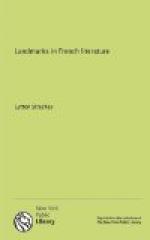he exclaims, with an accent of regretful softness different indeed from that of Vigny. Among much that is feeble, ill constructed, and exaggerated in his verse, strains of real beauty and real pathos constantly recur. Some of his lyrics are perfect; the famous song of Fortunio in itself entitles him to a high place among the masters of the language; and in his longer pieces—especially in the four Nuits—his emotion occasionally rises, grows transfigured, and vibrates with a strange intensity, a long, poignant, haunting note. But doubtless his chief claim to immortality rests upon his exquisite little dramas (both in verse and prose), in which the romance of Shakespeare and the fantasy of Marivaux mingle with a wit, a charm, an elegance, which are all Musset’s own. In his historical drama, Lorenzaccio, he attempted to fill a larger canvas, and he succeeded. Unlike the majority of the Romantics, Musset had a fine sense of psychology and a penetrating historical vision. In this brilliant, vivacious, and yet subtle tragedy he is truly great.
We must now glance at the effects which the Romantic Movement produced upon the art which was destined to fill so great a place in the literature of the nineteenth century—the art of prose fiction. With the triumph of Classicism in the seventeenth century, the novel, like all other forms of literature, grew simplified and compressed. The huge romances of Mademoiselle de Scudery were succeeded by the delicate little stories of Madame de Lafayette, one of which—La Princesse de Cleves—a masterpiece of charming psychology and exquisite art, deserves to be considered as the earliest example of the modern novel. All through the eighteenth century the same tendency is visible. Manon Lescaut, the passionate and beautiful romance of l’Abbe Prevost, is a very small book, concerned, like La Princesse de Cleves, with two characters only—the lovers, whose varying fortunes make up the whole action of the tale. Precisely the same description applies to the subtle and brilliant Adolphe of Benjamin Constant, produced in the early years of the nineteenth century. Even when the framework was larger—as in Le Sage’s Gil Blas and Marivaux’s Vie de Marianne—the spirit was the same; it was the spirit of selection, of simplification, of delicate skill. Both the latter works are written in a prose style of deliberate elegance, and both consist rather of a succession of small incidents—almost of independent short stories—than of one large developing whole. The culminating example of the eighteenth-century form of fiction may be seen in the Liaisons Dangereuses of Laclos, a witty, scandalous and remarkably able novel, concerned with the interacting intrigues of a small society of persons, and revealing on every page a most brilliant and concentrated art. Far more modern, both in its general conception and in the absolute realism of its treatment, was




